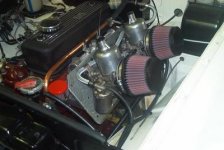wkilleffer
Jedi Knight
Offline
I sometimes read the MG mailing list from team.net, and they've had an interesting item over the past couple of days.
Someone on the list said that a good conversion for a chrome-bumpered or 74.5 car is to remove the smog pump and gulp valve, plug the holes, and also remove the crankcase vent that goes back into the inlet and plug it as well. Then use a long hose to vent the crankcase under the car.
Their reasoning was that anything like smog gear and breathers are a potential source of vacuum leaks, and that putting the crankcase vapors back through the inlet can take the fuel octane down.
Someone disputed this, but someone else said it was a credible conversion according to Lindsey Porter.
So, what are your thoughts on this? My car no longer has the smog pump nor the gulp valve, and the holes were well plugged. The crankcase still vents to the inlet. While I understand that it's an anti-pollution item, it also seems like it's sending dirty air back through the engine.
Any advice would be appreciated.
Thank you,
-Bill
Someone on the list said that a good conversion for a chrome-bumpered or 74.5 car is to remove the smog pump and gulp valve, plug the holes, and also remove the crankcase vent that goes back into the inlet and plug it as well. Then use a long hose to vent the crankcase under the car.
Their reasoning was that anything like smog gear and breathers are a potential source of vacuum leaks, and that putting the crankcase vapors back through the inlet can take the fuel octane down.
Someone disputed this, but someone else said it was a credible conversion according to Lindsey Porter.
So, what are your thoughts on this? My car no longer has the smog pump nor the gulp valve, and the holes were well plugged. The crankcase still vents to the inlet. While I understand that it's an anti-pollution item, it also seems like it's sending dirty air back through the engine.
Any advice would be appreciated.
Thank you,
-Bill

 Hi Guest!
Hi Guest!

 smilie in place of the real @
smilie in place of the real @
 Pretty Please - add it to our Events forum(s) and add to the calendar! >>
Pretty Please - add it to our Events forum(s) and add to the calendar! >> 

